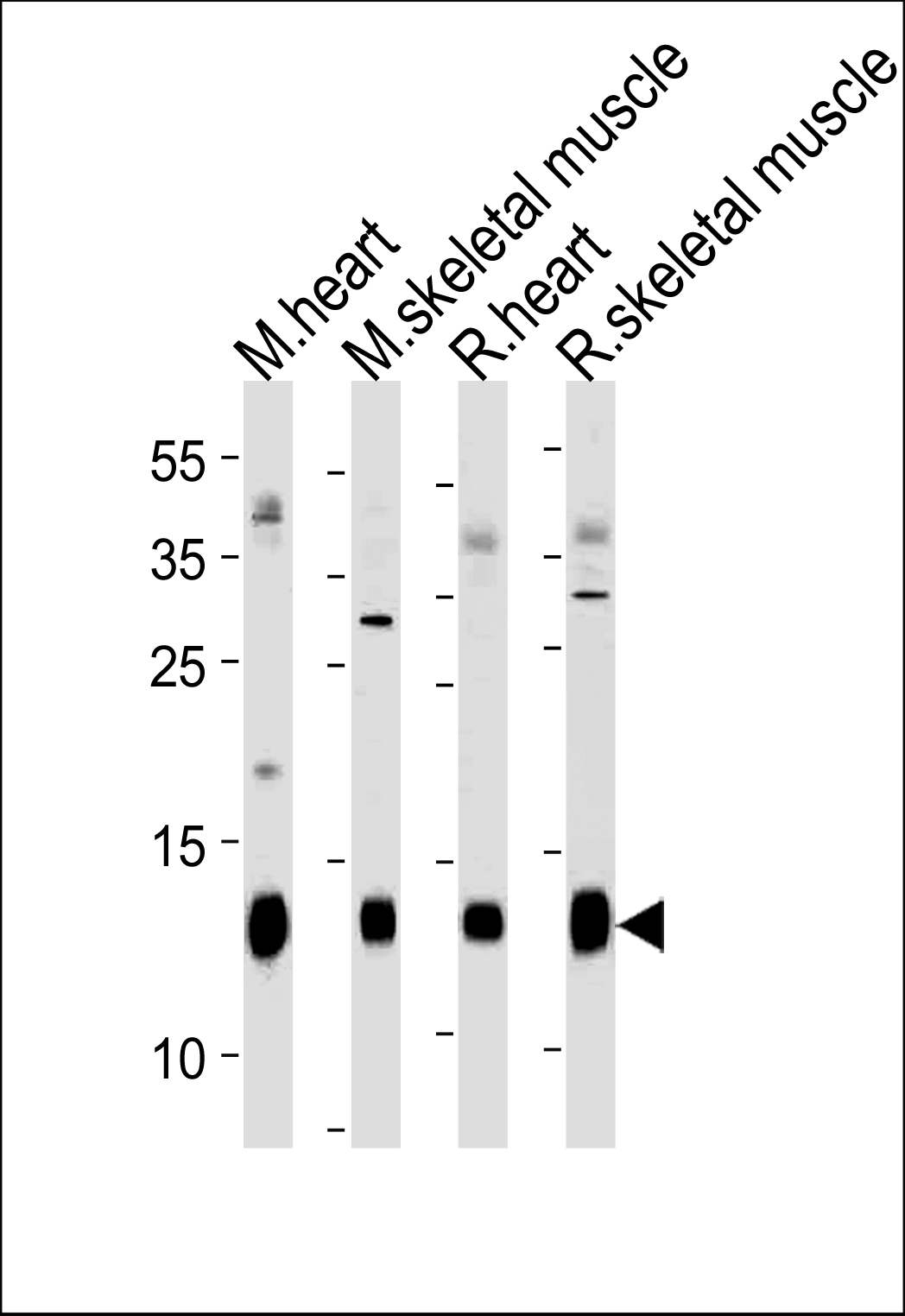Mouse PLM Antibody (N-term)
Purified Rabbit Polyclonal Antibody (Pab)
- 产品详情
- 文献引用 : 1
- 实验流程
- 背景知识
Application
| WB, E |
|---|---|
| Primary Accession | Q9Z239 |
| Other Accession | O08589 |
| Reactivity | Human, Rat, Mouse |
| Host | Rabbit |
| Clonality | Polyclonal |
| Isotype | Rabbit IgG |
| Calculated MW | 10323 Da |
| Antigen Region | 21-57 aa |
| Gene ID | 56188 |
|---|---|
| Other Names | Phospholemman, FXYD domain-containing ion transport regulator 1, Fxyd1, Plm |
| Target/Specificity | This Mouse PLM antibody is generated from rabbits immunized with a KLH conjugated synthetic peptide selected from the N-terminal region of mouse PLM. |
| Dilution | WB~~1:1000 E~~Use at an assay dependent concentration. |
| Format | Purified polyclonal antibody supplied in PBS with 0.09% (W/V) sodium azide. This antibody is purified through a protein A column, followed by peptide affinity purification. |
| Storage | Maintain refrigerated at 2-8°C for up to 2 weeks. For long term storage store at -20°C in small aliquots to prevent freeze-thaw cycles. |
| Precautions | Mouse PLM Antibody (N-term) is for research use only and not for use in diagnostic or therapeutic procedures. |
| Name | Fxyd1 {ECO:0000312|MGI:MGI:1889273} |
|---|---|
| Function | Associates with and regulates the activity of the sodium/potassium-transporting ATPase (NKA) which transports Na(+) out of the cell and K(+) into the cell (PubMed:15563542, PubMed:18065526). Inhibits NKA activity in its unphosphorylated state and stimulates activity when phosphorylated (By similarity). Reduces glutathionylation of the NKA beta-1 subunit ATP1B1, thus reversing glutathionylation- mediated inhibition of ATP1B1 (PubMed:21454534). Contributes to female sexual development by maintaining the excitability of neurons which secrete gonadotropin-releasing hormone (PubMed:19187398). |
| Cellular Location | Cell membrane, sarcolemma {ECO:0000250|UniProtKB:P56513}; Single-pass type I membrane protein. Apical cell membrane {ECO:0000250|UniProtKB:O08589}; Single-pass type I membrane protein. Membrane, caveola {ECO:0000250|UniProtKB:O08589}. Cell membrane, sarcolemma, T-tubule {ECO:0000250|UniProtKB:O08589}. Note=Detected in the apical cell membrane in brain. In myocytes, localizes to sarcolemma, t-tubules and intercalated disks. {ECO:0000250|UniProtKB:O08589} |
For Research Use Only. Not For Use In Diagnostic Procedures.

Provided below are standard protocols that you may find useful for product applications.
BACKGROUND
This gene encodes a member of the FXYD family of small membrane proteins that share a 35-amino acid signature sequence domain, beginning with the sequence PFXYD and containing 7 invariant and 6 highly conserved amino acids. The protein encoded by this gene is a plasma membrane substrate for several kinases, including protein kinase A, protein kinase C, NIMA kinase, and myotonic dystrophy kinase. It is thought to form an ion channel or regulate ion channel activity and act as an accessory protein of Na,K-ATPase. Alternative splicing of this gene results in multiple transcript variants which encode the same protein.
终于等到您。ABCEPTA(百远生物)抗体产品。
点击下方“我要评价 ”按钮提交您的反馈信息,您的反馈和评价是我们最宝贵的财富之一,
我们将在1-3个工作日内处理您的反馈信息。
如有疑问,联系:0512-88856768 tech-china@abcepta.com.






















 癌症的基本特征包括细胞增殖、血管生成、迁移、凋亡逃避机制和细胞永生等。找到癌症发生过程中这些通路的关键标记物和对应的抗体用于检测至关重要。
癌症的基本特征包括细胞增殖、血管生成、迁移、凋亡逃避机制和细胞永生等。找到癌症发生过程中这些通路的关键标记物和对应的抗体用于检测至关重要。 为您推荐一个泛素化位点预测神器——泛素化分析工具,可以为您的蛋白的泛素化位点作出预测和评分。
为您推荐一个泛素化位点预测神器——泛素化分析工具,可以为您的蛋白的泛素化位点作出预测和评分。 细胞自噬受体图形绘图工具为你的蛋白的细胞受体结合位点作出预测和评分,识别结合到自噬通路中的蛋白是非常重要的,便于让我们理解自噬在正常生理、病理过程中的作用,如发育、细胞分化、神经退化性疾病、压力条件下、感染和癌症。
细胞自噬受体图形绘图工具为你的蛋白的细胞受体结合位点作出预测和评分,识别结合到自噬通路中的蛋白是非常重要的,便于让我们理解自噬在正常生理、病理过程中的作用,如发育、细胞分化、神经退化性疾病、压力条件下、感染和癌症。






